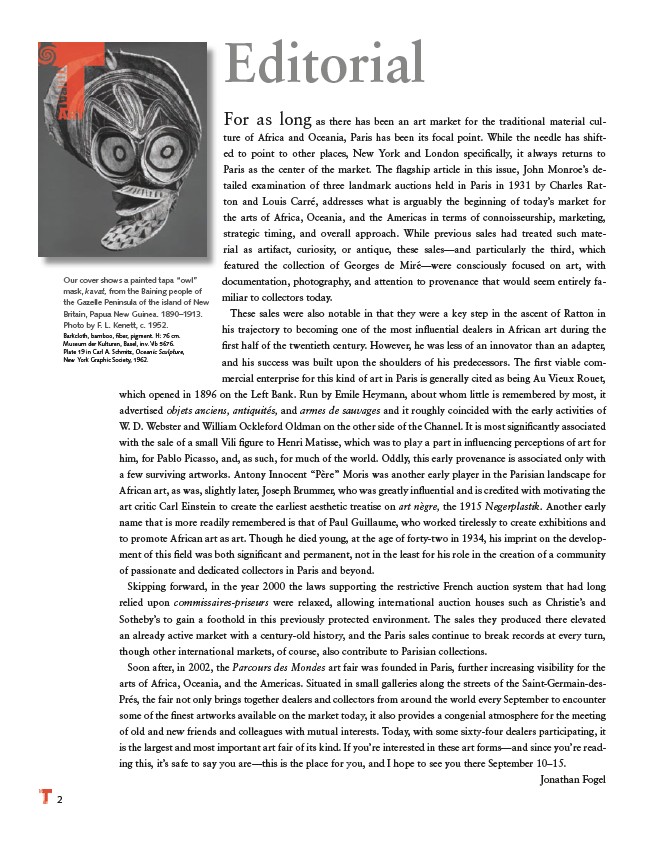
2
For as long as there has been an art market for the traditional material culture
of Africa and Oceania, Paris has been its focal point. While the needle has shifted
to point to other places, New York and London specifi cally, it always returns to
Paris as the center of the market. The fl agship article in this issue, John Monroe’s detailed
examination of three landmark auctions held in Paris in 1931 by Charles Ratton
and Louis Carré, addresses what is arguably the beginning of today’s market for
the arts of Africa, Oceania, and the Americas in terms of connoisseurship, marketing,
strategic timing, and overall approach. While previous sales had treated such material
as artifact, curiosity, or antique, these sales—and particularly the third, which
featured the collection of Georges de Miré—were consciously focused on art, with
documentation, photography, and attention to provenance that would seem entirely familiar
to collectors today.
These sales were also notable in that they were a key step in the ascent of Ratton in
his trajectory to becoming one of the most infl uential dealers in African art during the
fi rst half of the twentieth century. However, he was less of an innovator than an adapter,
and his success was built upon the shoulders of his predecessors. The fi rst viable commercial
enterprise for this kind of art in Paris is generally cited as being Au Vieux Rouet,
which opened in 1896 on the Left Bank. Run by Emile Heymann, about whom little is remembered by most, it
advertised objets anciens, antiquités, and armes de sauvages and it roughly coincided with the early activities of
W. D. Webster and William Ockleford Oldman on the other side of the Channel. It is most signifi cantly associated
with the sale of a small Vili fi gure to Henri Matisse, which was to play a part in infl uencing perceptions of art for
him, for Pablo Picasso, and, as such, for much of the world. Oddly, this early provenance is associated only with
a few surviving artworks. Antony Innocent “Père” Moris was another early player in the Parisian landscape for
African art, as was, slightly later, Joseph Brummer, who was greatly infl uential and is credited with motivating the
art critic Carl Einstein to create the earliest aesthetic treatise on art nègre, the 1915 Negerplastik. Another early
name that is more readily remembered is that of Paul Guillaume, who worked tirelessly to create exhibitions and
to promote African art as art. Though he died young, at the age of forty-two in 1934, his imprint on the development
of this fi eld was both signifi cant and permanent, not in the least for his role in the creation of a community
of passionate and dedicated collectors in Paris and beyond.
Skipping forward, in the year 2000 the laws supporting the restrictive French auction system that had long
relied upon commissaires-priseurs were relaxed, allowing international auction houses such as Christie’s and
Sotheby’s to gain a foothold in this previously protected environment. The sales they produced there elevated
an already active market with a century-old history, and the Paris sales continue to break records at every turn,
though other international markets, of course, also contribute to Parisian collections.
Soon after, in 2002, the Parcours des Mondes art fair was founded in Paris, further increasing visibility for the
arts of Africa, Oceania, and the Americas. Situated in small galleries along the streets of the Saint-Germain-des-
Prés, the fair not only brings together dealers and collectors from around the world every September to encounter
some of the fi nest artworks available on the market today, it also provides a congenial atmosphere for the meeting
of old and new friends and colleagues with mutual interests. Today, with some sixty-four dealers participating, it
is the largest and most important art fair of its kind. If you’re interested in these art forms—and since you’re reading
this, it’s safe to say you are—this is the place for you, and I hope to see you there September 10–15.
Jonathan Fogel
Editorial
Our cover shows a painted tapa “owl”
mask, kavat, from the Baining people of
the Gazelle Peninsula of the island of New
Britain, Papua New Guinea. 1890–1913.
Photo by F. L. Kenett, c. 1952.
Barkcloth, bamboo, fi ber, pigment. H: 76 cm.
Museum der Kulturen, Basel, inv. Vb 5676.
Plate 19 in Carl A. Schmitz, Oceanic Sculpture,
New York Graphic Society, 1962.